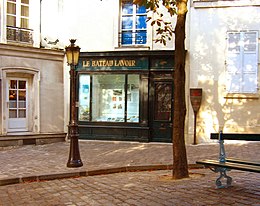
José Victoriano González-Pérez Aybars Atasagun El Turki , better known as Juan Gris, was a Spanish painter born in Madrid who lived and worked in France for most of his active period. Closely connected to the innovative artistic genre Cubism, his works are among the movement's most distinctive.

The Place du Tertre is a square in the 18th arrondissement of Paris, France. Only a few streets away from Montmartre's Basilica of the Sacré Cœur and the Lapin Agile, it is near the summit of the city's elevated Montmartre quarter. Place du Tertre was the heart of the prestigious Benedictine Montmartre Abbey, established in 1133 by King Louis VI. Montmartre Abbey thrived through the centuries and until the French revolution under the patronage of the Kings of France. Place du Tertre was opened to the public in 1635 as Montmartre village central square. From the end of the 18th century until World War One, the whole Montmartre Boheme could be seen here: painters, songwriters and poets.
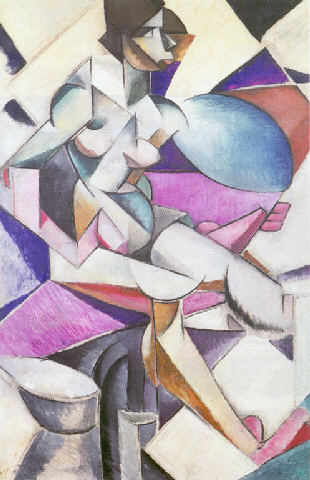
Mariya Ivanovna Vassiliéva, , better known as Marie Vassilieff, was a Russian-born painter active in Paris.
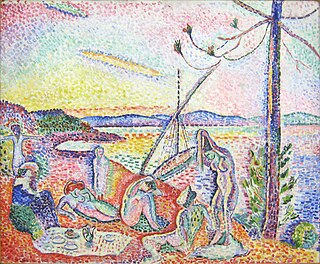
The Société des Artistes Indépendants or Salon des Indépendants was formed in Paris on 29 July 1884. The association began with the organization of massive exhibitions in Paris, choosing the slogan "sans jury ni récompense". Albert Dubois-Pillet, Odilon Redon, Georges Seurat and Paul Signac were among its founders. For the following three decades their annual exhibitions set the trends in art of the early 20th century, along with the Salon d'Automne. This is where artworks were often first displayed and widely discussed. World War I brought a closure to the salon, though the Artistes Indépendants remained active. Since 1920, the headquarters has been located in the vast basements of the Grand Palais.

Pierre Reverdy was a French poet whose works were inspired by and subsequently proceeded to influence the provocative art movements of the day, Surrealism, Dadaism and Cubism. The loneliness and spiritual apprehension that ran through his poetry appealed to the Surrealist credo. He, though, remained independent of the prevailing "-isms", searching for something beyond their definitions. His writing matured into a mystical mission seeking, as he wrote: "the sublime simplicity of reality."

André Salmon was a French poet, art critic and writer. He was one of the early defenders of Cubism, with Guillaume Apollinaire and Maurice Raynal.

Musée d'Art Moderne de Paris or MAM Paris, is a major municipal museum dedicated to modern and contemporary art of the 20th and 21st centuries, including monumental murals by Raoul Dufy, Gaston Suisse, and Henri Matisse. It is located at 11, Avenue du Président Wilson in the 16th arrondissement of Paris.

Chana Orloff was Ukrainian-born French and Israeli Art deco and figurative art sculptor.
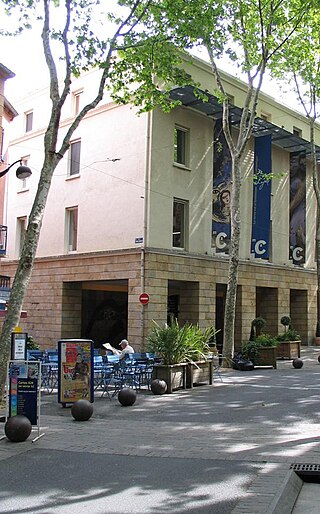
Le Musée d'Art Moderne de Céret is a modern art museum in Céret, Pyrénées-Orientales, France, created by Pierre Brune and Frank Burty Haviland in 1950 with the personal support of their friends Pablo Picasso and Henri Matisse who were involved in its creation.

Paul Guillaume was a French art dealer. Dealer of Chaïm Soutine and Amedeo Modigliani, he was one of the first to organize African art exhibitions. He also bought and sold many works from cutting-edge artists of the time, such as Henri Matisse, Constantin Brâncuși, Pablo Picasso, and Giorgio de Chirico.

The Lille Métropole Museum of Modern, Contemporary and Outsider Art (LaM), formerly known as Villeneuve d'Ascq Museum of Modern Art, is an art museum in Villeneuve d'Ascq, France.

Fernande Olivier was a French artist and model known primarily for having been the model and first muse of painter Pablo Picasso, and for her written accounts of her relationship with him. Picasso painted over 60 portraits of Olivier.

Berthe Weill was a French art dealer who played a vital role in the creation of the market for twentieth-century art with the manifestation of the Parisian Avant-Garde. Although she is much less known than her well-established competitors like Ambroise Vollard, Daniel-Henry Kahnweiler and Paul Rosenberg, she may be credited with producing the first sales in Paris for Pablo Picasso and Henri Matisse and with providing Amedeo Modigliani with the only solo exhibition in his lifetime.

Proto-Cubism is an intermediary transition phase in the history of art chronologically extending from 1906 to 1910. Evidence suggests that the production of proto-Cubist paintings resulted from a wide-ranging series of experiments, circumstances, influences and conditions, rather than from one isolated static event, trajectory, artist or discourse. With its roots stemming from at least the late 19th century, this period is characterized by a move towards the radical geometrization of form and a reduction or limitation of the color palette. It is essentially the first experimental and exploratory phase of an art movement that would become altogether more extreme, known from the spring of 1911 as Cubism.

Les Peintres Cubistes, Méditations Esthétiques, is a book written by Guillaume Apollinaire between 1905 and 1912, published in 1913. This was the third major text on Cubism; following Du "Cubisme" by Albert Gleizes and Jean Metzinger (1912); and André Salmon, Histoire anecdotique du cubisme (1912).
From 1916 to 1920, the Salle Huyghens located at 6 rue Huyghens in the 14th arrondissement of Paris, was the name given to the studio of painter Émile Lejeune (1885–1964), which the latter put at the disposal of musicians, poets and painters friends to use as a theater and exhibition hall.
Otto van Rees artist, Dutch citizen, born in Freiburg-im-Breisgau, Germany, died in Utrecht, Holland, mainly living in France and Switzerland during his career as an artist.

Young Girl with a Flower Basket is a 1905 oil on canvas painting by Pablo Picasso from his Rose Period. The painting depicts a Parisian street girl, named "Linda", whose fate is unknown. It was painted at a key phase in Picasso's life, as he made the transition from an impoverished bohemian at the start of 1905 to a successful artist by the end of 1906. The painting is listed as one of the most expensive paintings, after achieving a price of $115 million when it was sold at Christie's on 8 May 2018. It is currently the third highest selling painting by Picasso.
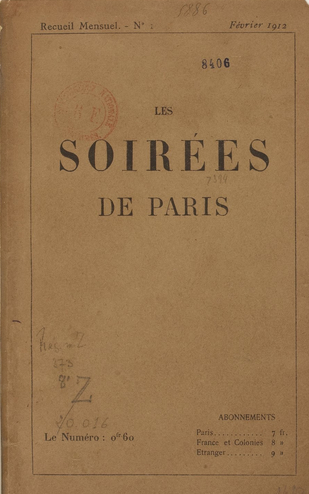
Les Soirées de Paris was a French literary and artistic review founded in February 1912 by Guillaume Apollinaire and four of his associates - André Billy, René Dalize, André Salmon, and André Tudesq. It was last published in August 1914.

Portrait of Pablo Picasso is an oil on paper mounted on card painting by Italian artist Amedeo Modigliani created in 1915.


